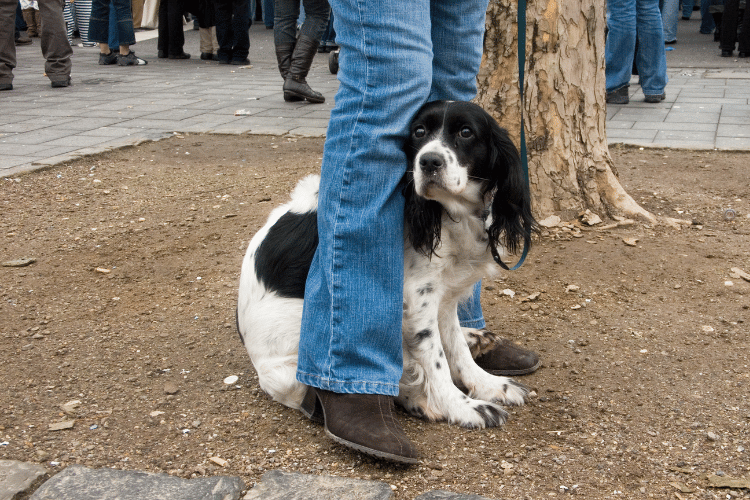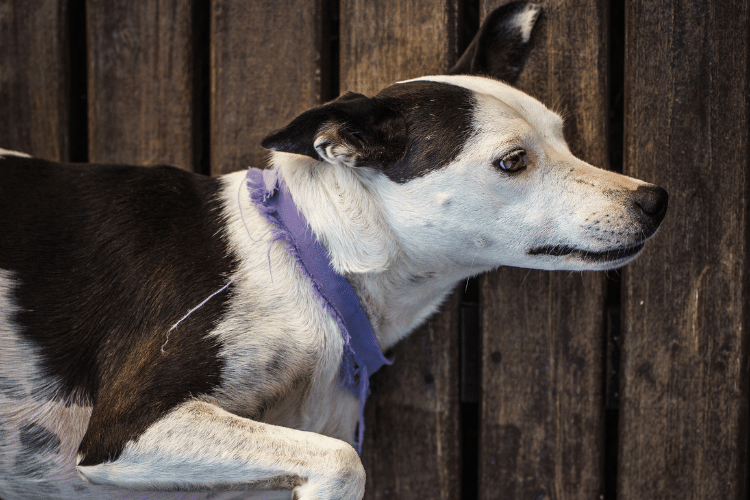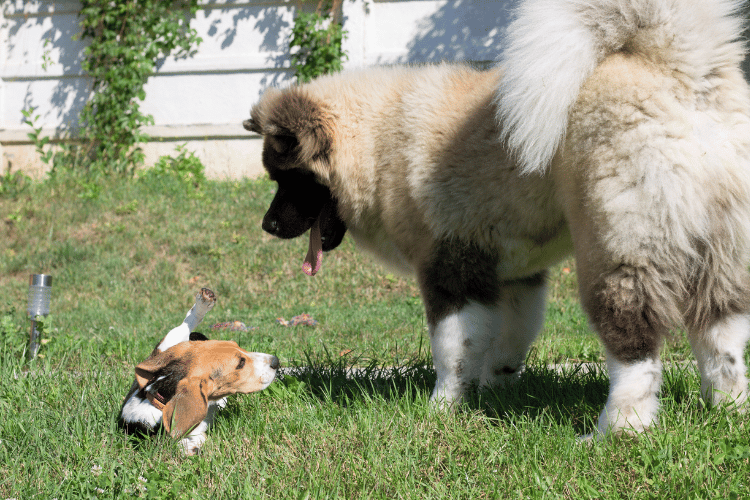So, you recently adopted a new dog, and it’s the cutest little angel in the world. One problem, though; they keep exhibiting submissive behavior! Whether it’s lowering their head, avoiding direct eye contact, or showing their bellies, your dog seems to be a wuss.
Why is this happening?
Submissiveness is a common phenomenon in dogs. While it’s not difficult to treat, making a wrong move can further instill it in your dog.
So, let’s see why your dog is submissive and what you can do about it.
Why Would a Dog Be Submissive?
There’s more to exhibiting submissive behavior than having a weak personality. You see, dogs are expressive creatures; they use their voice and body to convey specific information.
If your dog is lowering their head, tugging their tail between their legs, or not making direct eye contact, they’re trying to tell you something. The nature of that information depends on the situation you’re in.
Let’s see a few examples.
1. Fear of Strangers

Some types of dogs are social and interactive; others are not.
Your dog can exhibit submissive behavior when they’re around people they don’t know or in unfamiliar environments. It’s their way of showing they don’t like interacting with strangers.
It also doesn’t help if the dog hasn’t socialized enough when they were young. That could make them even more submissive.
2. Negative Environments
All dogs aren’t born equal. Some of them had to live in toxic environments where they faced physical abuse. Maybe they were harmed by their previous owners or other dogs.
These poor babies tend to exhibit submissive behavior whenever they face a person or a situation that might remind them of their past.
3. Age
Like humans, dogs get weaker as they get older. Unfortunately, when that happens, they tend to lose their assertive nature.
Even if your dog wasn’t submissive at first, losing their ability to defend themselves can force them to turn submissive. That’s why older dogs need extra attention and reassurance.
4. Anxiety
Yes, like humans, dogs can suffer from mental illnesses.
Anxiety is common with dogs, whether it’s because of frightening storms or separating from their owners. However, not every type deals with anxiety the same way.
Some can bark your ears away. Others become they can’t cope with whatever situation they’re in.
Are you interested in reading our post, My Dog Won’t Keep a Cone On (Answered).
5. Acknowledging an Alpha
Remember, dogs are descendants of wolves. They’re pack animals by nature. In these packs, there’s always an alpha, the leader, and there are low-ranking dogs, the followers.
If your dog exhibits submissive behavior, that could be their way of showing respect and acknowledging you’re the leader.
6. Play Call
So, you took your dog to the park, where they met another dog. After a few minutes of sniffing each other, you notice your dog has lowered their head.
Are they afraid of the other pup?
Not necessarily. It could be your dog’s way of saying they want to play with the other dog. Sometimes, they’ll lower their entire posture to what we call a play bow. It’s part of their body language, where they invite you or other animals to play.
7. Calming Signals
That’s an interesting one because it’s not actually submissive behavior.
You see, when dogs don’t know the intention of the person or animal in front of them, they calm themselves by licking their mouths or averting eye contact.
While they’re the same symptoms of submissive behavior, they’re actually calming signals.
Do Dogs Grow Out of Submissive Behavior?

Yes, most dogs grow out of their submissive behavior. That’s not always the case, though. Other variables factor into the equation.
For example, if your dog is submissive around strangers, not getting them used to socializing may perpetuate the problem. So, both you and the dog need to work it out together.
Are Submissive Dogs Unhappy?
There isn’t a definitive answer to that question, as it depends on why your dog is exhibiting submissive behavior. If it’s out of fear or anxiety, they’re probably not happy.
As we’ve already established, though, submissiveness isn’t always associated with illness. Your dog can exhibit submissive behavior out of respect for you. It could be part of their greeting routine. In that case, they can be as happy and healthy as any other dog in the world.
How Do I Change My Dog’s Submissive Behavior?
If your dog is submissive, you can help them become more confident. It might take a while, but the results will be worth it.
1. Take Your Dog Out More
Socializing is the most effective way to help your dog overcome social anxiety. Take them out as much as possible. Let them meet your friends and family members.
Take them to dog parks where they can meet other dogs (if they’re friendly enough). They might be nervous at first, but if you make it a daily routine, they’ll get used to social interactions.
You might be interested in this post if it’s relevant to your situation: My Dog Won’t Use the Dog Door: Why and What to Do
2. Train Your Dog
Whether it’s obedience or agility training, learning new tricks can help your dog grow out of their submissiveness. Gaining enough agility to course through various obstacles will boost their confidence, helping them become more dominant.
Additionally, if you show your dog how proud you are after excelling in obedience training, they’ll have enough reassurance to overcome submissiveness.
It’s worth noting that training can be counterproductive. If the training is too harsh, your dog might become more submissive. So don’t overdo it.
3. Tell Your Guests to Ignore Your Dog
Socializing isn’t the only way to make your dog get used to new visitors. Believe it or not, asking your guests to ignore your dog can help them become more comfortable. Submissiveness is a sign that your dog wants to be alone.
Having strangers approach them is a good way to shoot their anxiety levels through the roof. When you have new guests, ask them to sit on the floor so your dog doesn’t think they’re threatening, and not make direct eye contact.
Let the dog approach them. When that happens, don’t let your friends talk too sweetly to her. They should be casual and avoid making a big fuss about how cute your dog is. That will only instill submissiveness in them.
When they pet your dog, tell them to do it along the back because they might view head pats as a threat. Your dog will get used to your friends, and you can continue with the visit normally.
4. Reward Your Dog
Rewarding is the most effective way to instill specific behaviors in dogs. Do you remember how fulfilling it was when your parents bought you a new game after getting straight A’s? The same method works with dogs.
Whether it’s dog enrichment toys, treats, or baths, rewarding your dog after exhibiting confident behavior teaches them to repeat that behavior.
What Will Happen if You Don’t Treat Your Dog’s Submissiveness?

Not addressing your dog’s submissiveness can be dangerous for you. While some dogs show submissiveness by lowering their heads and averting eye contact, others try to appear as threatening as possible.
It’s a defense mechanism to protect themselves if they sense potential danger. As a result, you or your friends can get fear-bitten. So it’s better to address the problem immediately to avoid physical harm.
Can Submissive Dogs Protect Their Owners?
As you can see, submissiveness is associated with fear in many ways. So, can submissive dogs protect their owners in case there’s danger?
Yes, even submissive dogs will activate their protective instincts when they feel a threat, but not in a traditional sense.
For example, your dog can bark aggressively behind the door at incoming threats, but if faced with direct danger, they’ll resort to submissiveness.
After instilling some dominance, you can follow a daily program of protection training to help your dog become more vigilant.
Is a Submissive Dog Easier to Train Than a Dominant One?
You might think submissive dogs would be more open to training since they won’t be rebellious. While that could be true, it’s not always the case.
Training submissive dogs is a gamble. It might go well since they want to appease their owners, or you could fail because they’re not good at following directions.
Either way, you don’t want to follow discipline-based training, as it’d be too overwhelming for them. A reward-based program would be more effective.
Wrapping Up
Ultimately, submissive dogs can be as healthy, cuddly, and happy as dominant ones. However, when they exhibit excessive submissiveness, that’s when you should start worrying.
Start by identifying the trigger for submissiveness. Is it fear of strangers? Past trauma? Old age? Then, take countermeasures that cater to their needs.




